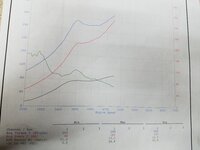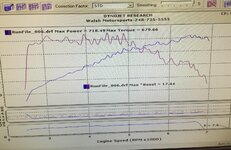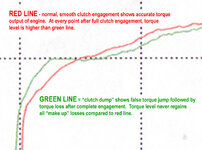kjlinwi
Proven Member
- 97
- 7
- Oct 22, 2015
-
near Madison,
Wisconsin
Took my wife's 97 eclipse in for an actual tune at a performance shop on a dyno for the first time. All previous tuning had been done by me as I figured out how to manipulate the ecmlink software.
Tuning shop made one run one on the dyno and said that the clutch is slipping. Never had a problem with the clutch other than I hate the way it engages (its a two stage clutch, I forget the brand name) its been in for two years and less than 5k on it. I've never had it slip and it still passes all the tests.
After the clutch was "slipping on the dyno" the engine still increased about 100 horsepower and 30 lb/ft of torque and both were still climbing at a steep angle on the dyno chart when they shut it off at 5000 rpm.
This doesn't look like clutch slipping to me but I'm curious what others with more dyno experience than I have to say about the dyno chart.
Tuning shop made one run one on the dyno and said that the clutch is slipping. Never had a problem with the clutch other than I hate the way it engages (its a two stage clutch, I forget the brand name) its been in for two years and less than 5k on it. I've never had it slip and it still passes all the tests.
After the clutch was "slipping on the dyno" the engine still increased about 100 horsepower and 30 lb/ft of torque and both were still climbing at a steep angle on the dyno chart when they shut it off at 5000 rpm.
This doesn't look like clutch slipping to me but I'm curious what others with more dyno experience than I have to say about the dyno chart.






















